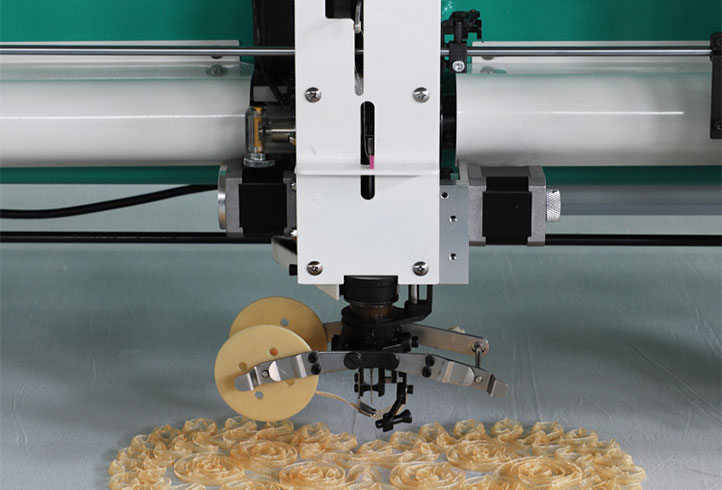Summary:(1) Rotary shuttle: The dust and lint of the non-woven fabric should be removed by brush (or blowing with compressed air...
(1) Rotary shuttle: The dust and lint of the non-woven fabric should be removed by brush (or blowing with compressed air) every shift (8 hours), the needle plate should be opened every two weeks, and a thorough removal should be carried out. Add a small drop of sewing machine oil so that the oil does not contaminate the embroidery.
(2) Frame and drive guide rails: It is mainly to clean up the debris in the guide rails. Since this is often the place where the thread balls and non-woven pieces cut off during embroidery enter, which affects the movement of the frame, you must pay attention to inspection at any time. Avoid the entry of sundries, and replenish the lubricating oil in time according to the lubrication condition of the guide rail surface, which should be twice a week (for example, the oil-losing machine will have pattern movement, disconnection, and increased noise, which will seriously affect the normal operation of the machine).
(3) Machine head thread tensioner: The thread take-up spring and the alarm piece should be kept clean at all times. Once the dust and other contamination are polluted, the disconnection alarm will fail, which will bring inconvenience to the normal work. If the rotation is uneven and inflexible, there may be felt mud stuck in the hole, etc., and it should be removed to ensure the smooth passage of the upper thread, and note that no lubricating oil is required on this part.
(4) Roller slide rail of needle bar frame: Because it is relatively exposed, it must be checked and cleaned frequently to ensure the normal operation of the color changing mechanism, and lubricating oil should be added once a week.

(5) Computer, electrical control and motor: keep the environment dry at ordinary times to avoid dust and moisture from invading the computer box and electrical parts, keep good ventilation, and promptly remove the dust on the surface and inside of the computer box and the grille at the rear of the motor. It is necessary to take moisture removal treatment. The simple method is to use a hair dryer to use its hot air for moisture removal treatment. It must be confirmed that the components such as connectors and circuit boards are absolutely moisture-free before powering on. At the same time, the connectors of electrical parts should be firm and reliable. Most of the electrical failures are caused by loose connectors or poor contact caused by dust on the connectors.
(6) All rotating parts: usually pay attention to cleaning, and the remaining coils cannot be placed arbitrarily, so as to prevent them from being entangled by the rotating shaft or wheel, causing unnecessary failures, especially the miscellaneous coils cannot be placed on the platen. If the thread ball is entangled by the lower shaft under the table or the synchronous belt of the Y-axis, the synchronous belt will be deformed, damaged, the frame cannot be moved or not in place, and the pattern in the embroidery will be scrapped, and the machine cannot Continue to work and discontinue production.
(7) Where there are red dots on the machine head (except for the thread wheel and the electromagnet clutch knob), generally add 7< oil (or use 1:1 sewing oil and motorcycle oil) once every 4 to 5 days to make the Oil does not leak from the bottom for degrees.
(8) The red dot on the panel of the needle bar holder indicates the refueling on the needle bar. Add 1 to 2 drops of 7< oil a week (or use 1:1 sewing oil and motorcycle oil), and the needle bar will not splash when moving. Leak is degree.
(9) For the refueling of the needle bar driver, add one drop of 7< oil a week (or use 1:1 sewing oil and motorcycle oil), add oil from the sink hole of the thread take-up guide for multi-needle machines, and use oil for single-needle machines The spout is added from the top of the driving shaft hole, that is, below the thread take-up gear of the needle bar frame.
(10) Grease (butter) once after cleaning the thread take-up lever gear in 2-3 months.
(11) There is an oil hole on the needle plate. Behind the needle hole, the oil hole is the oil filling hole of the rotary hook. A small drop of sewing machine oil should be added every 8 hours. High-speed automatic refueling hook is used, if oil can be refueled correctly (before refueling, first remove the non-woven dust on the oil hole, otherwise the dust will enter the oil hole channel and enter the rolling hole, which will increase the wear of the hook shaft and block the oil at the same time. If the oil is injected into the oil hole, it will automatically enter the guide rail in the rotary hook, and the rotary hook will be automatically lubricated. Remember, if there is oil loss in this place, firstly, the operating noise of the mechanism will increase, and the broken thread, skipped stitches, etc. will affect the normal work. Over time, the rotary hook shaft and the rotary hook will be seriously worn and cannot be used until they are scrapped, which will seriously affect the production.
(12) The bevel gear is generally filled with grease once every 3 months, which needs to be done after removing the needle plate.
(13) The other moving parts need to be checked frequently, and the corresponding lubricating oil should be filled in time to ensure flexible operation and prolong the service life of the machine.


